AMERICAN FOOTBALL MONTHLY THE #1 RESOURCE FOR FOOTBALL COACHES
Article CategoriesAFM Magazine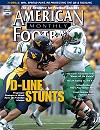
|
Pursuit, Tackling, and Takeawaysby: Kevin DohertyDefensive Coordinator, Harvard University © More from this issue As coaches, we have many formative years. We learn to scheme, we learn organization, we learn player relations, how to recruit, how to present, how to teach, motivate, package, adapt. There are certain things that have changed over time and there are some constants. Tackling and pursuit have always been trademarks of great defenses. More recently, takeaways has been a great indicator of team success. The goal of this article is to share with you how we go about achieving our maximum potential in these areas. We are all under time constraints and we are always looking for ways to maximize our efficiency in teaching. We will cover some of the organization and practice habits that have led to two undefeated seasons and the most successful five-year period in the vast history of Harvard football. Here are some of the ways we have found helpful in getting to the top of our conference. First, we do everything in our power to recruit players of character, players that have a tremendous work ethic, players that love the game of football and thrive in the challenges of the game. At the same time, we also believe that attitude and toughness can be practiced. We believe, practice, and preach that we will be the best pursuit team in the country. We run a sideline and pass pursuit drill that to me is the most competitive and game related drill I have seen used in this regard. We also run through bags as a unit that not only emphasizes agility and balance, but also drills tackling fundamentals, stripping the football, and scooping the football. Finally, we run a competitive takeaway circuit that drills the different techniques needed in a game. Everybody must be on the same page if we are to reach the top together. IF we all can’t make it, we cannot reach the goal: Our goal every year is to win the Ivy League Championship. Our practices are fast paced. Our drills are organized and there is constant movement. We coach on the run and our players work. I believe it is my job to put our players and coach’s in position to be successful. The following is just some thought on the rationale of our coaching methods. A. We must take advantage of the skills of our staff. We all have technical skills that we can share to advance the goals of the unit. Our D-Line coach can help teach pass rush to the secondary, our LB coach can teach tackling or a 2nd man strip, our secondary coach can drill D-Line drops. These are just examples, but we will utilize these areas of expertise in our circuit training. B. We will circuit train when teaching specific skills. This often happens in off-season, spring, or early in the fall. It is less frequent in season, but it is typically based on what I believe we most need to work on. It is somewhat an assembly line mentality. We work on the individual parts early. The pace at the beginning is not as intense but builds as the skills are mastered. Here we need to be very exact and demanding in our teaching. C. Once we have taught and drilled the finer details of our fundamentals, we incorporate these skills into drills that accomplish multiple tasks. We want these drills to be competitive, efficient, and accurately simulate some element of a game. Our menu looks something like this: A. Agility/Footwork B. Pursuit C. Tackling D. Takeaway’s (rake, punch, qb, cradle) E. Pass Rush Fundamentals F. Block Destruction, Leverage, Technique These drills teach teamwork, discipline, competitive behavior, and above all, executing specific technical skills in a competitive situation. This is critical. HARVARD PURSUIT This is a drill that can be used in the off-season. We put 4 players on the ground or on a matt in a crab position. On visual command, we move in multiple directions, we hit the ground and work up a good lather. I will then release them to a particular direction. We take a dog chasing a ball mentality. We want our guys to fight for pursuit. We teach them angles, but most of all we teach them to run full speed. When attacking the hand shield, we teach our players to finish with a perfect tackle or stripping action. We have documented on tape the results of great pursuit and a great finish. It truly is a controlled frenzy. We grade our players in any live situation. When grading pursuit, we identify a loaf as any change of speed to the ball carrier. This has also helped create that sense of urgency (See Diagram 1). 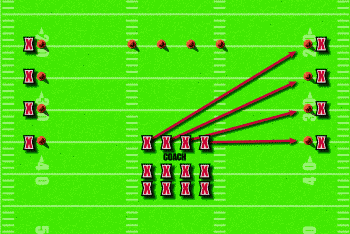
Diagram 1 Harvard Pursuit Drill Using the same set-up, we eliminate one of the targets so there are four competitors but only three successful finish positions. This is designed to foster competition. We will also adjust the start of the drill during the off season by using the monkey roll. This not only teaches body control, absorbing the ground, getting off the ground, but now the order of pursuit is random. Players, like a game, must sort through the chaos. The end result, we accomplish the following – sideline pursuit, pass pursuit, form tackling, strip from behind, great effort, competitiveness, and ultimately, attitude (See Diagram 2). 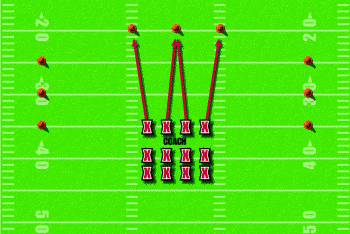
Diagram 2 Pursuit Drill Variation Major Coaching Points: • Never run in the same path of the same color jersey. • Finish with an explosive tackle with head across the bow. • With pass pursuit finish with a violent strip tackle. • Compete: the fastest man off the ground with open eyes wins. We train out players to compete – winning has a rewards and losing has its punishment. We believe that the winning edge is found in this practice. Up downs are issued to those players that do not finish with a winning result. In the past five seasons, we have never finished lower than second in the league, have won every overtime game, and have come back from significant deficits several times. In short, our players have been trained to never, ever give up. Tackling Football is a year round training endeavor; however, we only get the pads on for 9 practices in the spring and approximately 18 practices in our preseason. We therefore need to find ways to drill tackling w/o pads and when we are not in live practice. Here we focus on proper balance, leverage, approach, contact, and finish. We can honestly state that we work on tackling year round and with every practice. The teaching progression and coaching points are universal. We begin in simple form and continue to reinforce the same points throughout the year. Tackling takes proper balance, leverage, and explosive technique. We do not work on every type of tackle as a unit. As the secondary coach, a torpedo or spin tackle will need to be drilled individually while our LB or D-Line coach would work on a tackle more specific to their position. Our initial drill set up begins on air, progresses to a hand shield tackle, and then eventually evolves to thud or live drills. (See Diagram 3) 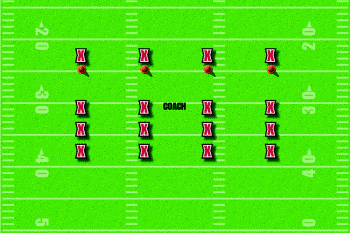
Diagram 3 Initial Tackling Drill Coaching Points & Commands: “Holster” – Players will get in proper position, knee’s bent, butt down, chest on thigh board, and hands on holstered position. “Shimmy” – Players will rapidly chop their feet. “ Hit” – While rolling off near foot, players will make first contact with front of chest, arms will explode up and through the edge’s of the hand shield (held by another player). We should see a pop or explosive movement off the ground by the tackler as his elbows and pinky fingers join together. The finish includes running our feet high and wide eyes to the sky. In periods versus our offense where contact is not permitted, we demand this same execution versus air so that we never endorse bad practice habits. Takeaway Statistically speaking, the team that has turned the ball over the fewest times will win. Conversely, we feel that if we lead the league in takeaways, we have given our team the best chance to win. The art of the takeaway must be practiced. Our menu is as follows: A. Strip from Behind (Rake) – Best used when the ball is not visually obvious. Be violent, you have one shot, slam a raked hand down on where you think the ball may be and pull either ball or arm towards you in a raking fashion. B. Strip from Behind (Punch) – Best used when the ball is in sight. Be violent and quick. Again you get only one shot. Punch through the ball with a fist. With both of these strips, the off hand must secure the tackle. C. Cradle – You would be surprised how many players do not know how to cradle the football. If it was not coached, half of our players would fall on the ball like it was a grenade. We teach getting into the fetal position. We have coach’s that will reach in to insure ball security. We teach the cradle when we are competing for the ball with our opponent. D. Scoop – We teach our players a one handed scoop through the fat part of the football. Knee’s bent, butt down, scoop and secure with the off hand. Like going for the interception, players must sense when to go for it and when to cradle. E. QB Strip – Using a pop up dummy with arms or a coach with a padded arm, we will work pass rush fundamentals or agility while finishing a violent rake on QB’s passing arm or on the ball. F. 2nd Man In – In a secured tackle, we want the 2nd man in to reach, pull, and spin the ball out. We do this by having a player with a hand shield in front in one arm and the 2nd hand on a ball. One player tackle’s/fit into the bag while the player approaching from an angle reach’s and corkscrews the ball out. Interception drills will be taught by position based on the judgement of each individual coach. The scoop and cradle is drilled in our unit bags. Our circuit typically has 3 parts. A strip from behind, the 2nd man in, and either some type of pass rush fundamental or tackling. We typically move in our positional groups while each coach will get to work with each position. Our primary drill is as follows (See Diagram 4): 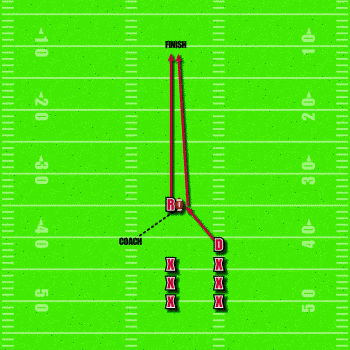
Diagram 4 Primary Takeaway Drill 1. Coach will toss the football or a rolled towel to a runner. He will be 2.5 yards in depth and width away from both the coach and defender. 2. The runner must secure the ball to the side of the chaser. The chaser may start as soon as the ball leaves the coach’s hand. 3. See coaching points listed previously. Above all: be violent. 4. The merits of this drill set up has been that the runner does not have significant time to secure the ball and because it is a race, the drill has a higher degree of realism. Unit Bags Drills Our agility drills through the bags are no different than 99% of America. What we do that we believe is unique is we vary the finish to each set. Our Finish Menu is a Hand Shield Tackle, a QB strip to each side on a Pop Up, and a Scoop and Score. We have 6 drills through the bags that we do not change so we get 2 reps of each types of finish. We have 3 sets of bags running at the same time so in approximately 6 minutes of time utilizing close to 50 players, we rep 300 agilities, 100 explosive tackles, 100 violent strips on the QB, and 100 scoops and scores. (See Diagram 5) 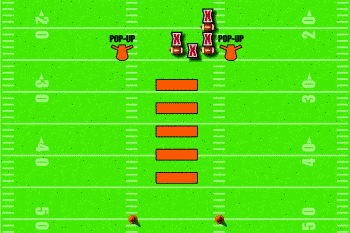
Diagram 5 Bag Drills Bag Drill 1. 1 in Hole - Explosive Tackle 2. 2 in Hole – Explosive Tackle 3. Crossover Run - QB Strip with Right Hand 4. Lateral Shuffle – QB Strip with Left Hand 5. Slalom Run - Scoop and Score Right Hand 6. Shuffle Bag Punch (simulates defeating cut block – Scoop and Score Left Hand.) Bags Drills We analyze the drills we use as a unit and within our positions to see if we are seeing the results on the field. In 2005, we placed an emphasis on takeaways and as a result, we were #1 in our conference in that area. In “The Game,” an interception for a touchdown lead to us overcoming what appeared to be an insurmountable lead and gave us a chance to play in overtime. In short, 3 overtimes and 3 takeaways later, Harvard wins the longest played game in Ivy League history. It is rare that you could define a season in such a short span of time, but putting “The Game” under a microscope, we would not have won if it were not for the following: 1. Tremendous attitude, confidence, and faith by our players to never give up, never lose faith, always stay poised. The winning edge. 2. Tremendous effort & pursuit & conditioning: a. Player’s running full speed on different angles to the ball. b. D-Line pursuing with a ball thrown, and stripping the football as the 2nd man in. c. Defender chasing and punching the ball out while another defender properly cradles and secures the football. We take a great deal of pride, thought, and effort into our preparation. We believe our package is both multiple and simple. Our system is designed to be able to attack and adapt. The bottom line, however, is our identity and our formula for championship football is the following: 1. Play with attitude. 2. Take away the football and get off the field. 3. Pursuit and tackle. On behalf of the Harvard Defensive Staff (John Butler, Jeff Commission, Scott Ruggles, and Dan O’Brien), I would like to thank American Football Monthly for the opportunity to share some of the ideas and practices we have implemented here at Harvard. I would also like to thank all the coach’s and clinicians that have shared ideas that have allowed us to develop in this great career. About the Author Kevin Doherty Defensive coordinator and defensive backs coach Kevin Doherty is in his fifth season on the Harvard staff. His defense was instrumental in Harvard’s perfect 2004 season holding its last six opponents to 14 points or fewer. Prior to coming to Harvard, Doherty was the defensive backfield coach at Connecticut. He also served as HC at St. Francis (PA) College and was an assistant at Marist College. A standout running back at Tufts, Doherty received his degree in 1987. Questions? If you have any questions you can email the author at: KevinDoherty@AmericanFootballMonthly.com |
|
| HOME |
MAGAZINE |
SUBSCRIBE | ONLINE COLUMNISTS | COACHING VIDEOS |
Copyright 2024, AmericanFootballMonthly.com
All Rights Reserved




